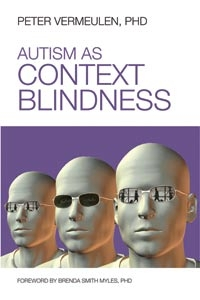Autism as Context Blindness
- 2012 INDIES Winner
- Honorable Mention, Reference (Adult Nonfiction)
“People with autism can learn…rules and procedures perfectly, but they get into trouble when the rules have to be adjusted to a context. It is not the rules that they have problems with; it’s those countless exceptions to the rules, especially the illogical exceptions.” Peter Vermeulen, who has more than twenty-five years of experience working with autism-spectrum disorders, believes that autism is not a behavioral matter but a cognitive disorder, one exacerbated by what he calls “context blindness.”
Autism as Context Blindness is remarkable for its human touch. This is a book of scholarly research with extensive endnotes and many clinical observations, yet it can make the reader smile. With appropriate illustrations and by citing case studies, the author quickly establishes that autistic people and “typical” people think in different ways. This is nothing new, but the breakthrough comes in understanding the concept of “context.” Ordinary people see a forest and quickly understand that it is made up of individual trees; autistic people see individual trees and may never grasp the idea of “forest” at all. The author uses several examples to illustrate his point. An autistic boy correctly identifies a doll, doll bed, mattress, and blanket, but says that the doll pillow is a “piece of ravioli.” An autistic man connects the name Karen to a coworker, but when a new Karen arrives he has to give her a different name. Autistic people are as capable as ordinary people of establishing connections, but they cannot sustain connectivity within a subtle and shifting contextual web. In a row of objects, most nonautistics would link an orange and a banana as being alike, whereas someone with autism might link a banana and a boomerang, and match the orange with a baseball. An autistic man may court his girlfriend by bringing her flowers late at night when she is asleep.
The difficulty of comprehension for people with autism increases because word meanings and physical settings change all the time. Consider this: A chocolate Easter egg looks like an egg but isn’t; a scrambled egg is an egg but doesn’t look like one. In one example, an autistic boy at camp refuses to use the toilets because they are not white like the one at home. Vermeulen begins each chapter with thought-provoking questions that offer perspective on how challenging the world can be for someone with context blindness: Are police officers who confiscate smugglers’ loot committing theft? How does one know which door to open when asked to “open the door”?
Vermeulen was drawn to study the potential of “context” by the work of Uta Frith, author of Autism: Explaining the Enigma; he credits her as the progenitor of his research on the subject. But Vermeulen has gone further, pursuing an in-depth scientific study of context blindness and suggesting methods to help “blind” autistics overcome their disabilities. Vermeulen asserts, “Context sensitivity cannot be explicitly taught. But we can compensate for context blindness.” The techniques involve expanding the autistic person’s “context” to include numerous “exceptions” that can be memorized to allow for appropriate behavior when the exception is encountered.
This fascinating and readily understandable book should be part of any library collection on the subject of autism. The author’s intention is “to help ensure that whoever is involved in autism, professionally or otherwise, has a better understanding of what is happening in the brains of those with autism.”
Reviewed by
Barbara Bamberger Scott
Disclosure: This article is not an endorsement, but a review. The publisher of this book provided free copies of the book and paid a small fee to have their book reviewed by a professional reviewer. Foreword Reviews and Clarion Reviews make no guarantee that the publisher will receive a positive review. Foreword Magazine, Inc. is disclosing this in accordance with the Federal Trade Commission’s 16 CFR, Part 255.

